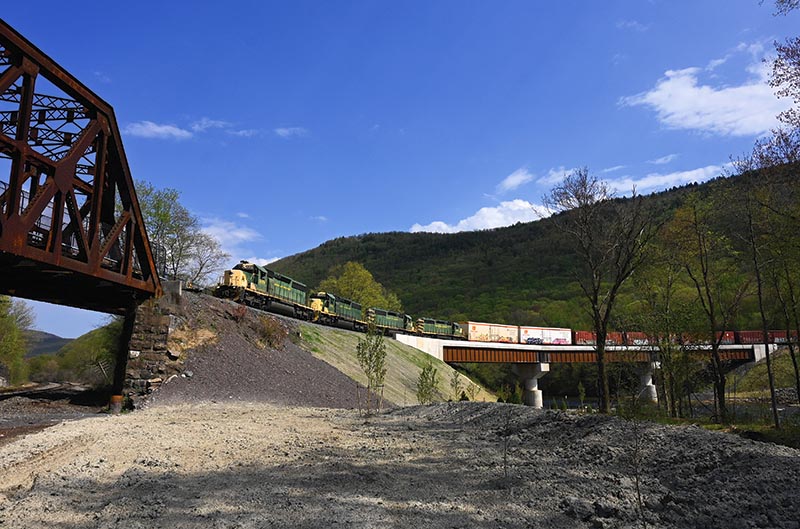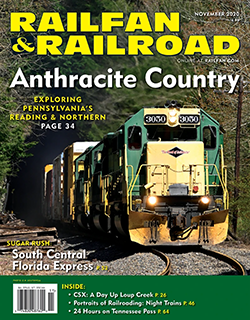 By C.N. Southwell/photos by the author
By C.N. Southwell/photos by the author
It’s a quiet Sunday morning in the neighborhood along North Main Street in Pittston, Pa. The railroad junction on the west side of the road opposite the neighborhood, however, has been busy since just after sunrise. A pair of GP38-2s has left with the Scranton train more than an hour ago, while a pair of erstwhile GP30s has departed westward up the Susquehanna River Valley with its local to Mehoopany. The sounds now come from a pair of EMD 567B prime movers nearing 70 years old under the hoods of Reading & Northern SW8s 801 and 803.
Before long, there is another sound, faint at first and then undeniable. It drowns out the former Lehigh Valley “pups” (switchers) and then the front porch coffee conversations. It’s the chuff of whirling helicopter blades forcing themselves through the air. The helicopter materializes over the treeline, then seems to pause. Slowly, the roaring monstrosity sinks out of the sky. He’s actually going to land in the parking lot of the yard office! The pups appear from around the corner during a switching move as the helicopter nears touchdown. Once on the ground, a man emerges from the cockpit. It’s the owner of the railroad, Andy Muller, out for a Sunday drive.
The entire neighborhood is on their porches watching the spectacle. Someone had called the police and I chatted with the constable after he arrived; both of us were somewhere between amused and amazed at what had transpired. Welcome to Reading & Northern.
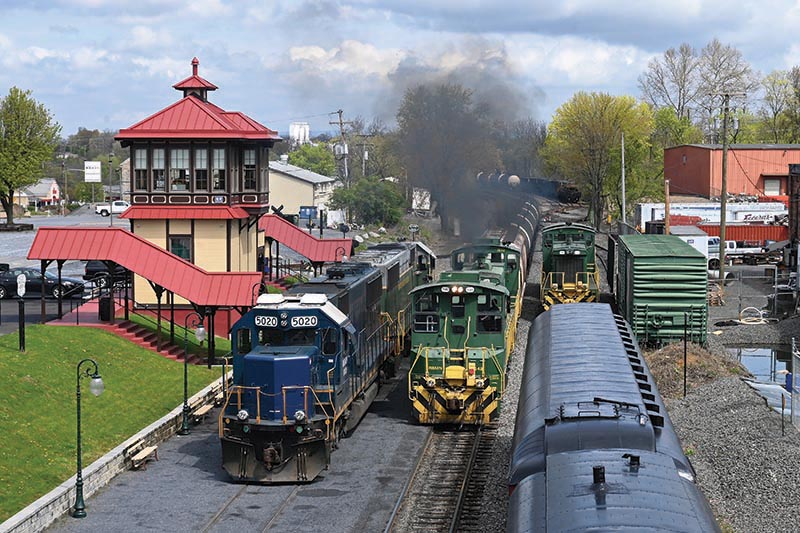
“Give it a start,” is the command from Evan Kerr as the YJNR1 kicks cars at North Reading on Saturday morning, April 25. The passenger platform partially occupied by the SD50s and the yard office patterned after a Reading Company interlocking tower were improvements completed in 2018 as part of the company’s increase in weekend passenger excursions.
Armed with maps, information from friends, and my trusty Nikon, I spent six dawn-to-dusk weeks along R&N during a pandemic which included “essential travel only,” masks, an economic nose-dive, closure of public spaces, toilet paper and meat shortages, national outrage, protests, and riots. Camping out in my truck, I toured the anthracite region of eastern Pennsylvania watching the railroad weather the storm around it as coal business suffered and car storage surged.
I’m not a local nor a lifelong fan, as many who follow the railroad are. I came to R&N for one reason — to capture the image of the railroad that echoes its green and yellow Reading Company heritage on second-generation EMD diesels. This was R&N in spring 2020. This was my spring in Anthracite Country.
From Blue Mountain to Reading & Northern
Andy Muller and some business associates formed Blue Mountain & Reading Railroad (BM&R) the same year I was born, 1983. They started with a moribund piece of the former Pennsylvania Railroad Schuylkill Division from Temple to Hamburg, Pa., and piece by piece expanded into a regional empire. Passenger excursions were a large part of the business in those early days.
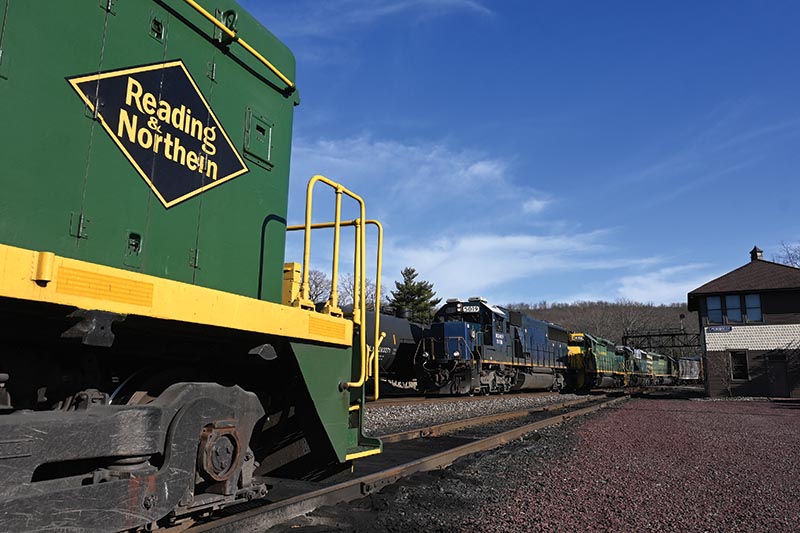
Recently acquired SD50-2 5019 passes underneath a former Jersey Central signal bridge and by the yard office (built new by R&N to Reading standards) at the south end of Penobscot Yard on April 20. The logo to the left is on the hood of SW8 802.
In 1990, they acquired what was known as the “Reading Cluster,” a large jumble of former Reading Company lines radiating north from Belt Line Junction in Reading into the anthracite fields that had turned fallow as a traffic source for Conrail. Through innovative marketing, great service, and sheer force of will, R&N developed business long thought to be extinct (a great source for this part of the story is Mike Bednar’s fantastic book Anthracite Rebirth).
With the Reading Cluster, BM&R also acquired a way to connect with Carbon & Schuylkill Railroad, the operator of the Carbon and Schuylkill counties-owned lines of Central Railroad of New Jersey, Reading, and LV ancestry running from Packerton Junction and a connection with Conrail at Lehighton to Oneida Junction near Hazleton. With this expansion also came a change in name to Reading, Blue Mountain & Northern (RBMN), often shortened to “Reading & Northern” for marketing purposes.
In 1992, Muller would acquire the rights to run on track operated by C&S from Schuylkill County, enabling RBMN to get from its Reading Cluster at East Mahanoy Junction to Oneida Junction. From there, trackage rights over a few miles of Conrail would get RBMN to its newly acquired Ebervale running track and access to the Jeddo Number 7 mine, the last anthracite mine served by Conrail. Carbon & Schuylkill itself had recently taken over the operation of the line and eventually would grant R&N rights to operate on C&S’ Carbon County-owned former CNJ from Lehighton to Haucks (near East Mahanoy Junction) upon RBMN’s purchase of the Lehigh Line in 1996. Eventually, this entire part of the railroad would be referred to as the Reading Division.
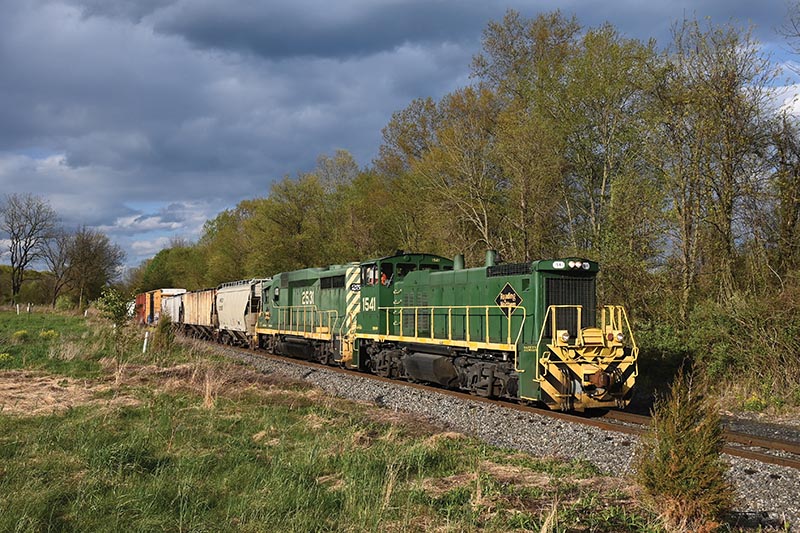
Under threatening skies, the North Reading Roustabout rolls toward home at Berne, Pa., on May 12 led by one of four ex-Southern MP15s painted in the scheme applied by Reading to locomotives of this same class.
Winter 1995–96 was tough on Conrail. Its Lehigh Line west of Allentown was still a viable through route, but lacking any true through traffic. The trains operated over it had effectively become long-distance local freights and traffic was sparse. A rapid thaw caused washouts in January 1996 in multiple locations north of Lehighton, specifically a large one at “Lookout,” in the Pocono Mountains near Mountain Top. Conrail wasted little time taking pieces of the line out of service and announcing its intent to sell.
On August 20, 1996, RBMN acquired what would be known as its Lehigh Division. This expansion included what had been known as Conrail’s Lehigh Line from Lehighton to near Mehoopany, comprised mostly of former LV track but also a stretch of the former CNJ that became part of LV’s main line after the 1960s line consolidations. It also encompassed a piece of the former Delaware, Lackawanna & Western Bloomsburg Branch and associated industrial trackage, taking RBMN north from Pittston to Scranton. With the increase in freight traffic came the end of the regular weekend passenger runs as the company transformed from local short line to growing regional railroad…


